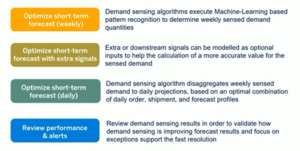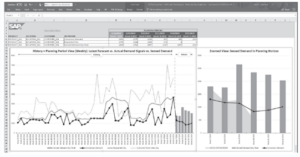The Art of Forecasting
Overcome Latency Issues with Demand Sensing
Meet the Authors
Key Takeaways
Demand sensing is a forecasting model based on current supply chain realities.
Demand sensing uses current data signals in the mathematical models to respond to a real-world current event.
Increased automation to leverage demand signals and increase forecast accuracy will result in less stock outs.
What is Demand Sensing?
Demand sensing is new to most organizations. It is a forecasting method that uses real-time information and mathematical techniques to create an accurate forecast of demand; based on current supply chain realities. The objective is to overcome latency issues, allowing planners to better anticipate short-term changes in demand.
If “art” can be defined as a skill acquired by experience, study, or observation, then the art of forecasting can be defined as the skill of taking immediate meaningful action. Taking meaningful action has become more difficult due to one supply chain crisis after another. That creates a challenge of working with months of biased or inapplicable sales data history. Historical models are useless when erratic sales patterns occur, and that is a problem. Increasingly complex supply chains require more intelligent forecasting. Supply chains must be prepared for potential disruption to ensure demand fulfillment.
Demand forecasting is the process of predicting consumer demand based on historical data and patterns. Traditional demand forecasting models rely on scientific analytic capabilities, as well as professional knowledge of market trends. These traditional techniques do not account for sudden shifts in market volatility or other disruptions that can affect the forecast. Instead, companies need to operate with greater agility and flexibility using forecasts that incorporate potential volatility into their models. Today, organizations are moving more aggressively into technology that offers precise methods for predicting consumer behavior. The true art of forecasting is dynamic and uniquely focused on the business itself.
Explore related questions
The difference between demand sensing and demand forecasting is that demand sensing uses current data signals in the mathematical models to respond to a real-world current event, rather than long-term historical data. Some examples of events that impact supply chains are market shifts in demand, social media, weather changes, or natural disasters. Demand sensing leverages real-time data, artificial intelligence (AI), and machine learning (ML) to create an accurate forecast based on the current scenario at hand. It can deliver incremental value to your supply chain by reducing costs and improving customer service. Strategic action from sensing demand signals can identify errors and allow for adjustments in short-term forecasts. Based on recent unprecedented supply chain challenges, you can see how this would be beneficial to your organization.
5 Ways to Improve Forecast Accuracy with Demand Sensing
- Drive with data. Utilize invoiced customer orders, current open customer orders, and point-of-sale data points to see current history and trends.
- Track the time. Get closer to your customers with short-term forecasts for the next four to eight weeks.
- Analyze macroeconomic indicators. Research aspects like purchasing index, consumer price index, employment, inflation, housing, and geopolitical events as early indicators for short-term trends.
- Review past and future promotions. Study the history of prior sales promotions and spikes to help predict future sales. Review what your competitors are doing to give you a competitive advantage.
- Monitor weather and natural disasters. Obtain early warning signals and react quickly if your industry experiences seasonal volatility or other weather events that constrain production.
Organizations that can produce accurate demand forecasting and planning are more likely to reach their revenue goals and achieve improvements to their bottom line. The secret sauce and the foundation for improving forecasting accuracy is in the data. Checking data is often the largest source of delay in a software implementation.
Forecast accuracy is only as good as the data. It is critical to invest time and resources into collecting data about business processes. AI driven software is an investment but with the ability to automate core functions and provide intelligent insights, ROI can be achieved in about a year. Machine learning algorithms need clean and organized data for proper modeling. The higher the quality of data, the better insights they can produce. Fast processes and accurate data are required to overcome planning and budgeting challenges.
Watch this video from SAP to learn how to bridge operational and tactical demand to achieve an optimal short-term forecast with demand sensing. The increase in automation to leverage demand signals and forecast accuracy will result in fewer stock outs. See the illustration below for the key components of SAP demand sensing.

Source: SAP
SAP allows you to see the results in the Microsoft Excel front-end of SAP Integrated Business Planning (IBP) for demand (as pictured below). The left side of the chart shows the various demand signals such as point of sale. The consensus demand here is indicated by the black dotted line. The right side of the chart shows the machine learning algorithm as it recognizes the demand patterns based on a range of factors: The left side has understated the demand.

Source: SAP
Benefits of SAP Demand Sensing include:
- Improved short-term forecasts
- Fewer stock outs and expedited shipments
- Improved planner productivity
- Lower safety stock levels
- Higher customer service
- Gain in market share and competitiveness
Traditionally, forecasters relied on their own experience when statistical tools reached their limits. With the unusual demand patterns of today, organizations still need to combine both the technological and human insights to achieve a dependable projection of future demand. AI provides both those technological (science) and human (art) insights that are essential for agile supply chains.
Additional insights for SAPinsiders are:
- Inventory planning is one of the most critical and challenging aspects in supply chain planning. Learn how you can evolve your inventory planning and management with advanced analytics. There is an opportunity to leverage a more holistic inventory planning process and strategically support inventory optimization by digitalizing your processes.
- It is imperative that companies plan against potential risks and proactively monitor their supply chains to course-correct quickly. Response and supply planning will help to improve efficiency, accuracy, and speed by enabling more intelligent plans and allowing better demand and inventory management.
What Does This Mean for SAPinsiders?
- Elevate customer service levels. By improving accuracy in short-term forecasting, you will have fewer stock outs and expedited shipments by optimizing inventory – improving customer service and reducing cost.
- Increase automation. Embrace the technology of AI and ML to inject digital technologies into your processes, with potential ROI in a year. Lower stock levels and improved customer service is a win-win.
- Improve short-term forecast accuracy. Implementing a streamlined process for forecasting in short-, mid- and long-term planning is essential for a competitive edge and market share gain. Strategic action from sensing demand signals can identify errors and allow quick action.









